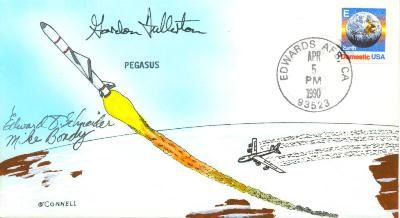Space Cover 286: PegsatOn April 5, 1990, Orbital Sciences Corporation began a new era in commercial space flight when their Pegasus rocket was launched from beneath a NASA B-52 aircraft in a mission that originated from Dryden Flight Research Center in California.
The three-stage Pegasus is used to deploy small satellites weighing up to 1,000 pounds into low-Earth orbit. Pegasus is carried aloft to approximately 40,000 feet over open ocean, where it is released and free-falls five seconds before igniting its first stage rocket motor.
The Pegsat satellite was the first satellite to be launched using the Pegasus rocket booster. The project involved DARPA, DoD, and NASA. The three-function payload included instrumentation to help establish the launch vehicle payload environment by measurement of variations in launch vehicle and spacecraft attitude, temperature, pressure, structural loading and vibrations. It also ejected a small Navy experimental communications relay satellite (SECS). The third function was a NASA pair of barium chemical release experiments. The experiments were part of a NASA plan to recover some of the science objectives lost when the CRRES spacecraft was reconfigured from a Shuttle launch to an Atlas-1 launch. The interactions of the released chemicals with the magnetic and electric fields in the Earth's magnetosphere and ionosphere were to be observed from a network of ground sites in central Canada and the United States. Both releases, on 16 April and 25 April 1990, were successfully observed by the ground sites.
The cover above is for the Pegsat launch cancelled at take-off location Edwards AFB, California and is signed by the crew of the B-52 – pilot astronaut Gordon Fullerton, co-pilot Edward Schneider and crewman Mike Bondy.













